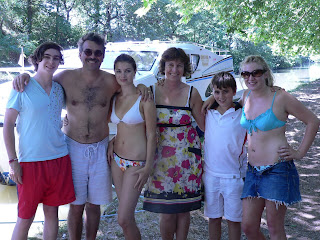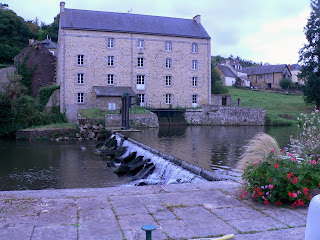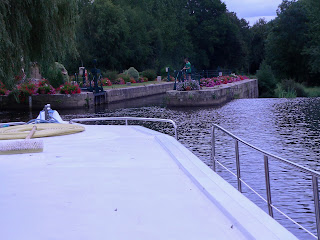We arrived Paris France via Charles Degaulle travelling on Icelandic Air. I made my first mistake asking the attendant at the metro info booth in English. He abruptly "Bonjours" me. Right then and there I knew I had to at least attempt to learn the French Language. We take the CVG shuttle to the RER metro and arrive at the Luxemborg station in Paris mid afternoon. It was August and the train was hot, smelly and crowded, no A-C. We stepped out onto to St. Michel Boulevard.
We checked into the Hotel St.Paul and then immediately hit the streets. We had the one evening before we would start our trip. In just two hours we got our first glimpse of Luxemborg Park, The Pantheon, The Sorbonne, Notre Dame. We walked along the Seine toward the Eifel Tower. The crowds were maddening, forcing us off the sidewalks into the street. We had to find a quieter area off the beaten track. We found a small restaurant with a prix Fixed Menu for 12 Euro's. We struggled with the menu not quite sure what we were orderring.
We awoke early, cabbed it to Orly Airport and took a flight via Air France to Toulose. After another two hour cab ride we reached our starting destination, the LocaBoat Marina on the Canal Midi in Negra. Our boat was named "Bages"....and as far we could tell named after a small town further south along the canal.
The idea of a waterway that would connect the Atlantic Ocean to the Mediterranean Sea dates back to the Roman Empire. Augustus, Nero, Charlemagne Henry IV, all dreamed of a water route that would be quicker than the land routes and the dangerous Iberian Peninsula sea route. The idea was to dig a series of canals that would connect several rivers across the country and above the watershed set 190 metres above sea level. The project was daunting and exceeded the skills of the period.
It wasn't until the "Great Reign" of Louis XIV (the Sun King) that the "Canal des Deux Mers" or Canal of two Seas, that the project was more seriously considerred. Feasability studies had determined the impossibility of it all. One simple uneducated man, a salt tax collector for the King changed all that. In 1662 at the age of 57, and after 15 years of research and experiments, Pierre Riquet convinced the King's Minister Colbert, that the obstacles that had prevented the building of the canal could now be overcome.
While Leonardo Da Vinchi is generally credited with inventing the lock where canals were first built in Northern Italy, it was Pierre Riquet that perfected them. Noting that straight walls were an inapropriate way to hold back the weight of the banks Riquet designed an oval shaped lock basin. The quality of building and materials employed are the reason why that even after 300 years thes locks are in remarkably usable condition. Riquet's work is impossible to miss.

The french have not forgotten Riquet. There was street named after him i n every village we visited.
One of the first of it's kind this aqueduct carries the canal of the river. Riquet was responsible
for over 350 unique engineering feats. His building of the Canal Midi and the subsequent obstacles that he overcame marks him as the most remarkable man of the 17th century.

At almost every lock is a lock keeper. Although most locks have automatic controls these days lock keepers provide an extra level of security and comfort, especially when locking up. They are provided with a small
cottage and most are well kept and full of flowers.
Each lock or "ecluse" has a sign showing the relative distance in kilometers in either direction. Depending on what part of the Canal you are on the locks can be as close as 100 metres or as far as 20,000! Frequent locking takes it toll though and can be a bother. It requires considerable attention and someone has to jump out of the boat onto the bank and tie up the boat. This requires some exertion and enthusiam. It has to be done carefully.
Here we are enterring a lock along the Canal Midi you can tell by the height of the gates that we are going upstream. The lock basins are uniform in size and the rise in elevation generally about 2 metres.
Both front and rear gates open and close in the same direction, toward the direction of the flow of water.This way the gates stay closed in the event of failure. Once closed, sluice gates open to let in or let out the water depending on whether one is locking up or locking down.
You can tell by the shallow reveal of the lock gates that here we are preparing to lock down.

Inside the lock basin......Locking up

The locking up and down process can take up to a half hour depending on whether you are waiting for other boats to exit or enter. Riquet's bulbous basins allow for up to 4 typical sized boats to lock up or down together. After the novelty of a couple of dozen locks wears ariving at an open gate is a House-Boater's dream come true.
There are at most only a handful of boats
in between locks. The lock are open from
9:00am - 7:00pm. They close from 12:00 till 2:00.
If your not where you want to be your stuck.
Here my wife Priscilla is waiting for the doors to full open
getting ready let go of the ropes having just finished locking down.
Occassionally you get in lock-step with some other boats and you can trail them in and out of the locks for hours. This is when you get to meet the other boaters. We were the only Americans on the water. There were Norwegians, British, Spanish and moslty French. I raised a hankerchief I had with an American flag
motif people would know who we were.
Most of the towns developed along the Canal as it was once the only route for commerce.
In the summer Southern France is flooded with tourists. The traffic was so bad in some places
there was gridlockk and no where to park. Here they look on interested and envious.
The old tow paths have been converted into bike paths and bikes can be rented and stored on the boat.
We met this Norwegian family one evening looking for a place to eat.
We were in lock-step with this English family and got pretty freindly with them. The
woman in the middle actually fell into the canal. We were sorry we missed it.
Buzet and the River Baise
From the moment we left our driveway in Providence we knew we were in for a Great Trip!
The first indication was on the way to Logan Airport in Bosotn. Route 95 was backed up for miles and miles....on the other side of the divider! After a quiet dinner in Brookline...we drove to the Park and Fly
on Route 1 in East Boston and had the van all to ourselves on the way to the airport. We were flying
Aer Lingus overnight into Charles Degaulle Airport in Paris with one stop in Dublin.
One hour into the flight a passenger became very sick...the call went out for " a doctor in the house". As
my wife is a Family practitioner with 25 years experience I immediately raised her hand. After 15 minutes
she determined the women was mostly just exhausted from dehydration and the plane would not have to return to Logan, she had the woman lie down across four empty seats in Bussiness class.
As we returned to our seats the stewardess motioned to me to come foward. We were in coach but we were comfortable so I waved her off. Again she motioned for us to come foward. So she sat us down in the near empty FIRST CLASS section and proceeded to wait on us hand and foot for the rest of trip to Dublin.
She sat us in those large, dentist like, reclinning chairs, served us wine and cheese and then a six course meal. I had the lamb stew! It's amazing how fast time flies when you are travelling first class! On the way out she handed us a fine bottle of French Wine.....which was promptly confiscated when we boarded the second half of our flight..............and we hadn't even made it to Paris yet!



Oh Britagne































































